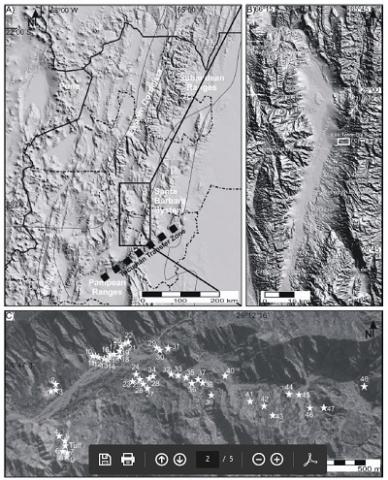Cecilia M. Spagnuolo, Sergio M. Georgieff, Augusto E. Rapalini
2 013
Latinmag Letters, Volume 3, Special Issue (2013), OB13, 1-5. Proceedings Montevideo, Uruguay
Se realizó el primer estudio magnetoestratigráfico en la Formación Las Arcas de edad miocena en las Sierras Pampeanas (26º 12´ S; 65º 47´ W) y se obtuvo la primera datación (8.79 ± 0.14 Ma) por el método Ar/Ar en una toba a 45 m de la base de la unidad Se estudió la columna aflorante, ~ 810 m de espesor, la cual pudo correlacionarse con la Escala de Polaridad Geomagnética Global (GPTS). Esta correlación indica que los sedimentos de la Formación Las Arcas habrían comenzado a depositarse a los 9.1 Ma. 26 de 48 sitios portan una remanencia magnética primaria que se usó para calcular un polo paleomagnético (D = 8.7° I = -43.9° A95 = 11.9) sugiriendo que el área tuvo una rotación de ~ 10° desde el Mioceno Tardío.
The first magnetostratigraphic study was carried out in the Miocene Las Arcas Formation, in the
Northern Pampean Ranges (26º 12´ S; 65º 47´ W) and furthermore the first dating (8.79 ± 0.14 Ma) of
the unit was obtained at 45 m from the unit base. ~ 810 m of sedimentary rocks were sampled obtaining a magnetostratigraphic column that was correlated with the Geomagnetic Polarity Time Scale (GPTS). This
correlation indicates that deposition of the Las Arcas Formation sediments started at around 9.1 Ma. 26 from 48 sites carry a primary magnetization that was used to calculate a paleomagnetic pole (D = 8.7° I = -43.9° a95 = 11.9°) that suggests that this area underwent a rotation of ~10º since the Late Miocene.
Northern Pampean Ranges (26º 12´ S; 65º 47´ W) and furthermore the first dating (8.79 ± 0.14 Ma) of
the unit was obtained at 45 m from the unit base. ~ 810 m of sedimentary rocks were sampled obtaining a magnetostratigraphic column that was correlated with the Geomagnetic Polarity Time Scale (GPTS). This
correlation indicates that deposition of the Las Arcas Formation sediments started at around 9.1 Ma. 26 from 48 sites carry a primary magnetization that was used to calculate a paleomagnetic pole (D = 8.7° I = -43.9° a95 = 11.9°) that suggests that this area underwent a rotation of ~10º since the Late Miocene.

